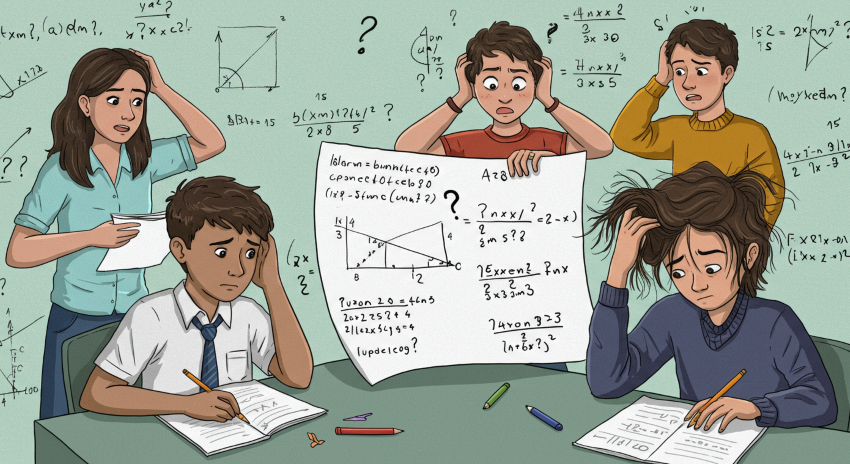
“Ugh, math homework again?”
Sound familiar? Whether you’re a student staring at a page full of problems, or a parent trying to help, you’re not alone! For many, math feels like a list of boring tasks, tricky ideas, and the stress of getting the “right” answer. We often see it as just another school subject, something to get through, instead of what it really is: a super useful way to understand and interact with the world.
Schools try their best, teaching us about fractions, algebra, and all those other math topics from the textbook. We solve problems for homework and then move on to the next chapter. But here’s a big question that often gets missed: Why? Why are we learning this stuff, and will we ever actually use it outside of school?
What is Real Life Math ?
Imagine this:
Instead of starting a lesson on percentages with confusing formulas, what if your class started a small project, like a bake sale? Students could decide what to bake (cookies, anyone?), decide the proportion using ratio of ingredients, figure out how much the ingredients cost (using addition and multiplication), decide on a selling price to make a profit (using percentages and subtraction), keep track of sales, and then see how much money they made (or lost!).
Suddenly, ideas like “ratio and proportions”, “cost,” “selling price,” and “profit” aren’t just words in a book; they’re real things you’ve worked with. After doing something like this, the textbook questions make more sense because you’ve already seen these ideas in action. The math isn’t just memorized; it’s understood. This is learning beyond textbooks.
Everyday things are packed with math. When parents and teachers point out these “math moments,” they help kids get curious and comfortable with numbers and thinking logically. Math doesn’t have to be scary; it can be part of playing and exploring.
As kids get older, these early experiences make the harder math ideas easier to understand. If a child has already figured out how to share a pizza fairly with friends, fractions in a textbook won’t seem so strange. If they’ve saved up their allowance to buy a toy they really wanted, they’ll get how percentages work for discounts or saving money.
I remember a student asking me, with a big sigh, “Why am I studying trigonometry? All these weird words like sine, cosine… what’s the point?” I gave him the usual answer: “It’s super important for engineers who build bridges and big buildings, and for pilots and sailors to find their way.”
He listened, then said, “That’s nice, but I don’t want to be an engineer or a pilot. I want to study criminology – you know, solve crimes.”
My examples were good, but they didn’t connect with his dreams. It was a big “aha!” moment for me and I had to look into it. And guess what? I found some really cool ways trigonometry is used in criminology:
- Analyzing Blood Spatters: Trigonometry helps figure out the angle blood hit a surface, which can tell investigators where it came from and what might have happened at a crime scene.
- Understanding Bullet Paths: Calculating how bullets fly uses trigonometry.
- Figuring Out Car Accidents: Detectives use math, including trigonometry, to work out how fast cars were going and how they hit, based on skid marks and damage.
And suddenly, trigonometry wasn’t just a boring chapter; it was a tool to shape up his goal. This taught me something vital: every single math idea, no matter how weird it seems, is used in real life, somewhere, somehow. The trick is to find that connection and show it to students in a way that clicks with them.
So, how do we change math from something to dread into something exciting? It takes everyone –working together.
For Parents:
- Be Positive About Math: Try not to say things like, “I was never good at math.” Instead, show you’re curious and willing to explore math ideas with your child.
- Find Math in Everyday Life:
- Cooking together? Talk about measurements.
- Shopping? Discuss prices, discounts, and which item is a better deal.
- Planning a family trip? Look at maps, distances, travel times, and costs.
- Playing board games or card games? Many use strategy, chance, and counting.
- Focus on Understanding, Not Just the Right Answer: Ask your child to explain how they got an answer, and why they think it is right. Praise them for trying and for their thinking, even if they make mistakes.
- Support Their Interests: If your child loves space, explore the math behind planets and stars. If they love video games, show them how math makes those games work.
For Teachers:
- Start with “Why”: Begin new topics by showing cool, real-world examples, especially ones that connect with different student interests. Start with the “ BIG WHY?”
- Do More Hands-On Projects: Let students use math in real ways, like the bake sale idea.
- Be a Detective for Connections: If a student is struggling or seems bored, try to find out what they’re passionate about. Then, look for ways math connects to that passion and share the stories.
- Make it Okay to Make Mistakes: Learning math often means trying things and sometimes getting them wrong. Create a classroom where students feel safe to ask questions and learn from their errors.
Next time you see a math problem, whether you’re a student, a parent, or a teacher, try to look past just “doing homework.” Ask “why,” look for the real-world connections, and remember: You’re not just doing math — you’re learning a skill that helps you make sense of the world, solve problems, and reach your goals. Let’s make math less of a chore and more of an exciting adventure!🙂